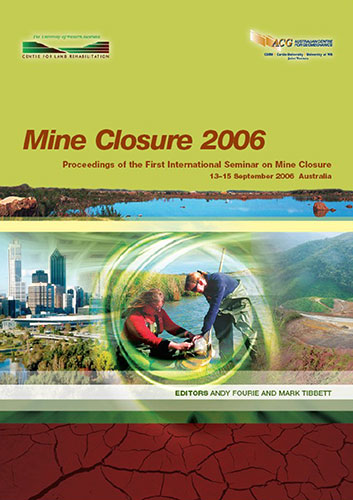Ecological Drivers in Mine Site Rehabilitation

|
Authors: Diaz, A; Green, I; Smith, B; Carrington, I Paper is not available for download Contact Us |
DOI https://doi.org/10.36487/ACG_repo/605_Diaz
Cite As:
Diaz, A, Green, I, Smith, B & Carrington, I 2006, 'Ecological Drivers in Mine Site Rehabilitation', in AB Fourie & M Tibbett (eds), Mine Closure 2006: Proceedings of the First International Seminar on Mine Closure, Australian Centre for Geomechanics, Perth, pp. 51-60, https://doi.org/10.36487/ACG_repo/605_Diaz
Abstract:
REHABILITATION The creation of sustainable ecosystems on land that has been used for other purposes is an increasingly important facet of global biodiversity conservation. Mine sites offer particular opportunities and challenges for ecological restoration. Opportunities such as the ability to make large scale adjustments to edaphic and topographical factors are combined with challenges such as obtaining appropriate sources for any species re- introductions and rehabilitating several trophic layers. In this paper we explore a range of potential drivers involved in successful ecological rehabilitation on mine sites and review the results from experimental studies investigating the importance of these drivers.
References:
Dallinger, R. (1993) Strategies of metal detoxification in terrestrial invertebrates. In R. Dallinger and P.S. Rainbow
(eds), Ecotoxicology of Metals in Invertebrates, Lewis Publishers, Chelsea, MA, pp. 245-289.
Etterson, J.R. (2004) Evolutionary potential of Chamaecrista fasciculate in relation to climate change. I. Clinal patterns
of selection along an experimental gradient in the Great Plains. Evolution 58, pp. 1446-1458.
Gaston, K.J. (2000) Global patterns in biodiversity Nature 405 (6783), pp. 220-227.
Glowacka, E., Migula, P., Nuorteva, S-L., Nuorteva, P. and Tulisalo, E. (1997) Psyllids as a potential source of heavy
metals for predators. Archives of Environmental Contamination and Toxicology 32, pp. 376-382.
Grime, J.P. (1997) The humped-back model: A response to Oksanen. Journal of Ecology 85(1), pp. 97-98.
Guegan, J.F., Lek, S. and Oberdorff, T. (1998) Energy availability and habitat heterogeneity predict global riverine fish
diversity. Nature 391(6665), pp. 382-384.
Hoare, A. (1999) An Evaluation of Downland Turf Re-creation, using Invertebrates as Indicators. PhD Thesis:
Bournemouth University.
Hufford, K.M., and Mazer, S.J. (2003) Plant ecotypes: genetic differentiation in the age of ecological restoration.
Trends in Ecology and Evolution, 18, pp. 147-155.
Huston, M. (1979) General Hypothesis of Species-Diversity. American Naturalist 113 (1), pp. 81-101.
Janssen, M.P.M., de Vries, T.H. and van Straalen, N.M. (1991) Comparison of Cd kinetics in four soil arthropod
species. Archives of Environmental Contamination and Toxicology 20, pp. 305-312.
Janssen, M.P.M., Ma, W.C. and van Straalen, N.M. (1993) Biomagnification of metals in terrestrial ecosystems. The
Science of the Total Environment, Supplement 1993, pp. 511-523.
Keller, M., Kollmann, J. and Edwards, P.J. (1999) Palatability of weeds from different European origins to the slugs
Doroceras reticulatum Müller and Arion lusitanicus Mabille. Acta Oecologia, 20, pp. 109-118.
Kerr, J.T., Southwood, T.R.E. and Cihlar, J. (2001) Remotely sensed habitat diversity predicts butterfly species richness
and community similarity in Canada. Proceedings of the National Academy of Sciences of the United States of
America 98 (20), pp. 11365-11370.
Kershaw, K.R., Mitchley, J., Buckley, G.P. and Helliwell, D.R. (1995) Slope protection and establishment of vegetation
on channel tunnel spoil in an environmentally sensitive coastal sit. In: Vegetation and Slopes, Thomas Elford:
London.
Knapp, E.E. and Dyer, A.R. (1997) When do genetic considerations require special approaches to ecological
restoration? In: P.I. Fiedler and P.M. Kereiva (eds) Conservation Biology for the Coming Decade. Chapman and
Hall: London.
Plenary Addresses
Mine Closure 2006, Perth, Australia 59
Kramarz, P. (1999) Dynamics of accumulation and decontamination of cadmium and zinc in carnivorous invertebrates
2. The centipede, Lithobius mutabilis Koch. Bulletin of Environmental Contamination and Toxicolog 63, pp.
538-545.
McKay, J.K., Christian, C.E., Harrison, S. and Rice, K.J. (2005) How local is local? - A review of practical and
conceptual issues in the genetics of restoration Restoration Ecology 13, pp. 432-440.
Mitchley, J., Buckley, G.P. and Helliwell, D.R. (1996) Vegetation establishment on chalk marl spoil: the role of nurse
grass species and fertiliser application. Journal of Vegetation Science 7, pp. 543-548.
Mittelbach, G.G., Steiner, C.F., Scheiner, S.M., Gross, K.L., Reynolds, H.L., Waide, R.B., Willig, M.R., Dodson, S.I.
and Gough, L. (2001) What is the observed relationship between species richness and productivity? Ecology,
82(9), pp. 2381-2396.
Posthuma, L. and van Straalen, N.M. (1993) Heavy metal adaptation in terrestrial invertebrates- A review of
occurrence, genetics, physiology and ecological consequences. Comparative Biochemistry and Physiology C-
Pharmacology, Toxicology and Endochrinology, 106 (1), pp. 11-38.
Rabitsch, W.B. (1995) Metal accumulation in arthropods near a lead/zinc smelter in Arnoldstein, Austria I.
Environmental Pollution 90, pp. 221-237.
Stevenson, M.J., Bullock, J.M. and Ward, L.K. (1995) Re-creating semi-natural communities: Effect of sowing rate on
establishment of calcareous grassland. Restoration Ecology 3, pp. 279-289.
Straalen van, N.M. and Ernst, W.H.O. (1991) Metal biomagnification may endanger species in critical pathways. Oikos
62, pp. 225-256.
Van der Tienderen, P.H. and Van der Toorn, J. (1991) Genetic differentiation between populations of Plantago
lanceolata. 1. Local adaptation in three contrasting habitats. Journal Ecology 79, pp. 27-42.
Vijver, M.G., Wolterbeek, H.T., Vink, J.P.M. and van Gestal, C.A.M. (2005) Surface adsorption of metals onto the
earthworm Lumbricus rubellus and the isopod Porcellio scaber is negligible compared to absorption in the body.
Science of the Total Enivronment, 340, pp. 271-280.
Ecological Drivers in Mine Site Rehabilitation A. Diaz, et al.
60 Mine Closure 2006, Perth, Australia
© Copyright 2025, Australian Centre for Geomechanics (ACG), The University of Western Australia. All rights reserved.
View copyright/legal information
Please direct any queries or error reports to repository-acg@uwa.edu.au
View copyright/legal information
Please direct any queries or error reports to repository-acg@uwa.edu.au